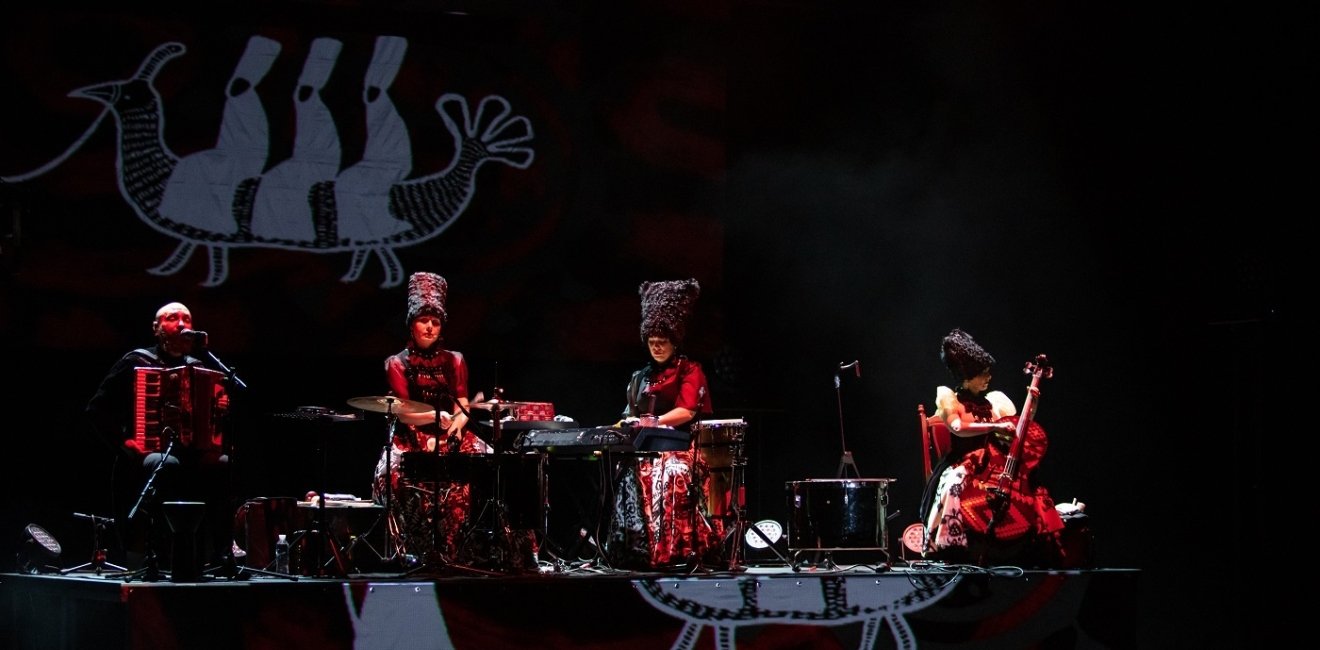
A blog of the Kennan Institute
BY BLAIR A. RUBLE
Cities have nurtured the creative explosion of unanticipated propinquity ever since humans began to gather in permanent settlements more than nine millennia ago. This phenomenon is especially true in cities that take shape on the borders of once distinct nations and cultural systems. Memorable art often emerges from eras and places when life is most unsettled. Twenty-first-century Kyiv is such a city, as was on display at the famed New Orleans Jazz Fest the afternoon of April 30 when the Ukrainian capital’s music ensemble DakhaBakha took the stage.
Writing in the prominent New Orleans cultural lookout Gambit, longtime local aficionado Will Coviello reported how DakhaBrakha took the overflowing Cultural Exchange Pavilion tent by storm. Coviello noted that the quartet “describes itself as a world music quartet, and it draws on Ukrainian folk songs, classical training, vocal tricks, and more.… The group often harmonizes on top of a good rhythm coming from just bass drum and cello. Sometimes they chant haunting vocals, and at times they divert into instrumental interludes.” In other words, a performance that exudes just the sort of stunning intercultural mashup that so often emerges from the mixing bowls of cities—such as New Orleans—struggling for self-definition in the face of intense cultural fusion.
DakhaBrakha grew out of a chance encounter at the Kyiv Center of Contemporary Art “DAKH” by avant-garde theater director Vladislav Troitskyi and Kyiv National University of Culture and Arts graduates Marko Halanevuch (vocals, percussion, harmonica, accordion, and other instruments), Olena Tsybulska (vocals and percussion), and Iryna Kovalenko (vocals, piano, ukulele, accordion, and other instruments). Cellist and vocalist Nina Garentska quickly joined the mix.
While Coviello was uncertain how to describe DakhaBrakha’s unique sound, Troitskyi, the group’s director and self-proclaimed “ideologist,” offers a more concise description of the group as the embodiment of Ukrainian “ethnic chaos.” Fittingly, the group’s name means “Give/Take” in an older Ukrainian language.
Beyond category, DakhaBrakha fits most comfortably into current notions of world music. Starting with Ukrainian folk music as its base, the group combines Indian, African, Russian, and Australian traditional and European classical instrumentation to produce a music that has never been heard before. Its power grows from the creative eruption unleashed by the contradictory cultural, social, and political forces that have characterized postindependence Ukraine. For all its paradoxes, this new culture rests—as does DakhaBrakha’s unique sound—on a profoundly Ukrainian sensibility.
The group garnered considerable international success and had long planned a post-COVID international tour for April. Agonizing over whether to embark on the trip once the war started, the group concluded that its performances in North America could help generate support for Ukraine. If the sea of blue-and-yellow flags on display at their New Orleans performance offers any indication, they made a winning choice.
DakhaBrakha reveals a more profound truth about postindependence Ukraine. Precisely because so many issues of identity remained unresolved (at least until President Putin’s army provided cohesion), Ukrainian culture has been energized by the mixing and matching of different heritages, histories, and identities. This “give/take” was not random; neither was it chaotic. The process was the result of Ukrainians determined to define Ukraine for themselves. Unlike neighboring Russia, where imposing a false sense of order and illusory unanimity became the goal of the day, Ukraine has emerged as the more creative fulcrum. Today’s Ukraine speaks powerfully to those coming of age in the twenty-first century. DakhaBrakha’s pulsating success reveals how something powerful was taking shape beneath the seeming anarchy of Ukraine’s daily and political life.
Critics of the dissonance of urban life have complained for millennia that cities undermine human well-being through their tumultuous knocking together of seemingly irreconcilable cultures, lifestyles, belief systems, economic interests, social classes, and political factions. History is more complicated: some of humankind’s most exceptional accomplishments have been forged by such give and take. In the twenty-first century, Kyiv joins the long list of cities that demonstrate how this comes about.
The opinions expressed in this article are those solely of the authors and do not reflect the views of the Kennan Institute.
Author

Former Wilson Center Vice President for Programs (2014-2017); Director of the Comparative Urban Studies Program/Urban Sustainability Laboratory (1992-2017); Director of the Kennan Institute for Advanced Russian Studies (1989-2012) and Director of the Program on Global Sustainability and Resilience (2012-2014)

Kennan Institute
The Kennan Institute is the premier US center for advanced research on Eurasia and the oldest and largest regional program at the Woodrow Wilson International Center for Scholars. The Kennan Institute is committed to improving American understanding of Russia, Ukraine, Central Asia, the South Caucasus, and the surrounding region through research and exchange. Read more

Explore More in Focus Ukraine
Browse Focus Ukraine
Talking to the Dead to Heal the Living

Ukrainian Issue in Polish Elections


